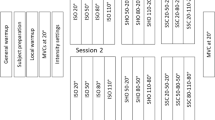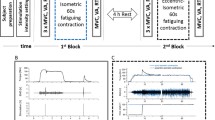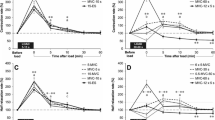Abstract
The net mechanical efficiency of positive work (ηpos) has been shown to increase if it is immediately preceded by negative work. This phenomenon is explained by the storage of elastic energy during the negative phase and its release during the subsequent positive phase. If a transition time (T) takes place, the elastic energy is dissipated into heat. The aim of the present study was to investigate the relationship between ηpos and T, and to determine the minimal T required so that ηpos reached its minimal value. Seven healthy male subjects were tested during four series of lowering–raising of the body mass. In the first series (S 0), the negative and positive phases were executed without any transition time. In the three other series, T was varied by a timer (0.12, 0.24 and 0.56 s for series S 1, S 2 and S 3, respectively). These exercises were performed on a force platform sensitive to vertical forces to measure the mechanical work and a gas analyser was used to determine the energy expenditure. The results indicated that ηpos was the highest (31.1%) for the series without any transition time (S 0). The efficiencies observed with transition times (S 1, S 2 and S 3) were 27.7, 26.0 and 23.8%, respectively, demonstrating that T plays an important role for mechanical efficiency. The investigation of the relationship between ηpos and T revealed that the minimal T required so that ηpos reached its minimal value is 0.59 s.



Similar content being viewed by others
References
Asmussen E, Bonde-Petersen F (1974) Apparent efficiency and storage of elastic energy in human muscles during exercise. Acta Physiol Scand 92:537–545
Aura O, Komi PV (1986) Mechanical efficiency of pure positive and pure negative work with special reference to the work intensity. Int J Sports Med 7:44–49
Aura O, Komi PV (1987) Effects of muscle fiber distribution on the mechanical efficiency of human locomotion. Int J Sports Med 8(Suppl 1):30–37
Bosco C, Komi PV, Ito A (1981) Prestretch potentiation of human skeletal muscle during ballistic movement. Acta Physiol Scand 111:135–140
Bosco C, Ito A, Komi PV, Luhtanen P, Rahkila P, Rusko H, Viitasalo JT (1982) Neuromuscular function and mechanical efficiency of human leg extensor muscles during jumping exercises. Acta Physiol Scand 114:543–550
Bosco C, Saggini R, Viru A (1997) The influence of different floor stiffness on mechanical efficiency of leg extensor muscle. Ergonomics 40:670–679
Cavagna GA, Saibene FP, Margaria R (1964) Mechanical work in running. J Appl Physiol 19:249–256
Cavagna GA, Mazzanti M, Heglund NC, Citterio G (1985) Storage and release of mechanical energy by active muscle: a non-elastic mechanism? J Exp Biol 115:79–87
Dalleau G, Belli A, Bourdin M, Lacour JR (1998) The spring–mass model and the energy cost of treadmill running. Eur J Appl Physiol Occup Physiol 77:257–263
Gaesser GA, Brooks GA (1975) Muscular efficiency during steady-rate exercise: effects of speed and work rate. J Appl Physiol 38:1132–1139
Gibbs CL, Chapman JB (1974) Effects of stimulus conditions, temperature, and length on energy output of frog and toad sartorius. Am J Physiol 227:964–971
Gibbs CL, Gibson WR (1972) Energy production of rat soleus muscle. Am J Physiol 223:864–871
Goubel F, Marini JF (1987) Fibre type transition and stiffness modification of soleus muscle of trained rats. Pflugers Arch 410:321–325
Komi PV, Kaneko M, Aura O (1987) EMG activity of the leg extensor muscles with special reference to mechanical efficiency in concentric and eccentric exercise. Int J Sports Med 8(Suppl 1):22–29
Pousson M, Perot C, Goubel F (1991) Stiffness changes and fibre type transitions in rat soleus muscle produced by jumping training. Pflugers Arch 419:127–130
Stainbsy WN, Gladden LB, Barclay JK, Wilson BA (1980) Exercise efficiency: validity of base-line subtractions. J Appl Physiol 48:518–522
Thys H, Faraggiana T, Margaria R (1972) Utilization of muscle elasticity in exercise. J Appl Physiol 32:491–494
Thys H, Cavagna GA, Margaria R (1975) The role played by elasticity in an exercise involving movements of small amplitude. Pflugers Arch 354:281–286
Wendt IR, Gibbs CL (1973) Energy production of rat extensor digitorum longus muscle. Am J Physiol 224:1081–1086
Whipp BJ, Wasserman K (1972) Oxygen uptake kinetics for various intensities of constant-load work. J Appl Physiol 33:351–356
Acknowledgements
The experiments comply with current Swiss laws.
Author information
Authors and Affiliations
Corresponding author
Rights and permissions
About this article
Cite this article
Henchoz, Y., Malatesta, D., Gremion, G. et al. Effects of the transition time between muscle-tendon stretch and shortening on mechanical efficiency. Eur J Appl Physiol 96, 665–671 (2006). https://doi.org/10.1007/s00421-005-0124-2
Accepted:
Published:
Issue Date:
DOI: https://doi.org/10.1007/s00421-005-0124-2




